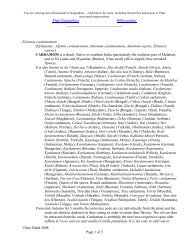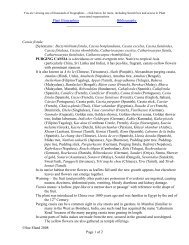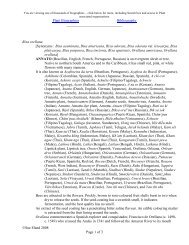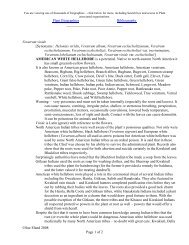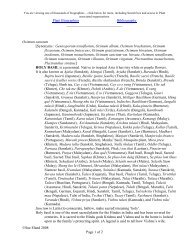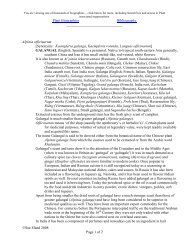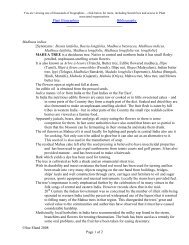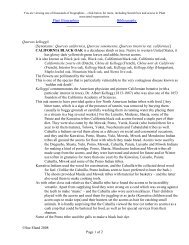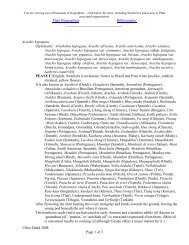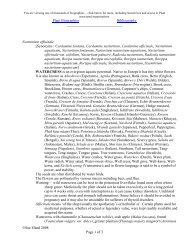You are viewing one of thousands of ... - Plant Biographies
You are viewing one of thousands of ... - Plant Biographies
You are viewing one of thousands of ... - Plant Biographies
You also want an ePaper? Increase the reach of your titles
YUMPU automatically turns print PDFs into web optimized ePapers that Google loves.
<strong>You</strong> <strong>are</strong> <strong>viewing</strong> <strong>one</strong> <strong>of</strong> <strong>thousands</strong> <strong>of</strong> biographies – click below for more, including Search box and access to <strong>Plant</strong><br />
associated organisations.<br />
<strong>Plant</strong> <strong>Biographies</strong> Bibliography<br />
______________________________<br />
Pimpinella anisum<br />
[Synonyms : Anisum <strong>of</strong>ficinarum, Anisum vulg<strong>are</strong>]<br />
ANISEED is an erect or prostrate annual. Native from Greece to Egypt it has many small <strong>of</strong>fwhite<br />
flowers.<br />
It is also known as Anice (Italian), Anijs (Dutch), Anis (Creole, French, German, Russian,<br />
Spanish, Swedish), Anise (English, Italian), Anise burnet saxifrage, Anise plant, Anisi<br />
(Gujarati, Maltese), Anisoon (Urdu), Anisruoho (Finnish), Anissamen (German), Anizo<br />
(Esperanto), Anny, Anysun (Arabic), Badian (Hindi), Bedrník anýz (Czech), Bedrovník<br />
(Slovak), Chombu (Tamil), Common anise, Erva-doce (Portuguese), European anise,<br />
Green anise, Huei-hsiang (Chinese), Jintan manis (Malay), Kuppi sopu (Telugu), Mahaduru<br />
(Singhalese), Muhuri (Bengali), Roman fennel, Saunf (Indian), Shetapusapa<br />
(Sanskrit), Shombu (Malayalam), Simiente de anis (Spanish), Somp (Marathi), Sompu<br />
(Kannada), Sop (Oriya), Sweet Alice, Sweet cumin, and Valaiti saunf (Hindi, Punjabi).<br />
Warning – the seeds and the toothpastes (that use aniseed as an ingredient) have been known<br />
to cause symptoms similar to chapped lips. It is poisonous for pigeons.<br />
Seeds produced commercially can vary in quality according to their variety and source. Spanish<br />
anise that happen to be the largest and <strong>are</strong> otherwise known as Alicante anise have been<br />
considered by many to be the best.<br />
The seeds <strong>of</strong> aniseed have been confused with those <strong>of</strong> hemlock (Conium maculatum) and<br />
Japanese star anise (Illicium anisatum).<br />
Anisum is an old name for anise (or aniseed).<br />
Cultivated by the ancient Egyptians as long ago as 1500 BC – and then by the ancient Greeks,<br />
the Arabs and the Romans aniseed’s medicinal and culinary uses have been recognized<br />
for hundreds <strong>of</strong> years. It was probably also <strong>one</strong> <strong>of</strong> the at least 36 ingredients used by<br />
Mithridates (c.132-63 BC), the 1 st Century King <strong>of</strong> Pontus (northern Turkey), in a poison<br />
antidote (known as Antidotum Mithradaticum or Theriac) which he took daily to acquire<br />
an overall immunity – an important consideration if it is remembered that he gained his<br />
position <strong>of</strong> power by poisoning his opposition. For the Chinese it was also revered as a<br />
sacred plant.<br />
The Romans grew the seed (particularly in Tuscany) and it was <strong>one</strong> <strong>of</strong> the most important<br />
ingredients in a cake they served after a rich meal to aid digestion. This cake <strong>of</strong>ten<br />
appe<strong>are</strong>d at the end <strong>of</strong> a marriage feast too and may well have been the precursor <strong>of</strong><br />
today’s wedding cake in the West. Another sweetmeat that authorities certainly trace to a<br />
modern counterpart was the hard aniseed-flavoured lozenge distributed to the people after<br />
victories by the Roman general, Quintus Fabius Maximus Cunctator (c. 260-died 203<br />
BC). These dragati <strong>are</strong> put forward as the forerunners <strong>of</strong> the dragées or Jordan almonds<br />
(coated with sugar and <strong>of</strong>ten aniseed-flavoured) familiar at French baptisms and<br />
weddings today. Apart from featuring in Roman sweetmeats aniseed also seems to have<br />
been <strong>one</strong> <strong>of</strong> the spices used for the payment <strong>of</strong> taxes (although some authorities dispute<br />
the reference to it in the New Testament <strong>of</strong> the Christian Bible and suggest that<br />
translations should have referred to dill, Anethum graveolens). Today still in India the<br />
end <strong>of</strong> a meal is <strong>of</strong>ten signalled when a dish <strong>of</strong> whole or ground seeds is served – as a<br />
digestive aid. While for the Chinese it is <strong>one</strong> <strong>of</strong> the ‘Five Spices’ [the others <strong>are</strong> star anise<br />
©Sue Eland 2008<br />
Page 1 <strong>of</strong> 2
(Illicium verum), cinnamon (Cinnamomum verum), clove (Syzygium aromaticum) and<br />
fennel (Foeniculum vulg<strong>are</strong> var. dulce)] familiar in their cooking.<br />
Aniseed’s spread throughout Europe could be said to be laid at the door <strong>of</strong> Charlemagne (747-<br />
814), king <strong>of</strong> the Franks and Christian emperor <strong>of</strong> the West. In the Middle Ages aniseed<br />
was valued as a culinary spice and medicine as well as being an ingredient in<br />
aphrodisiacal potions. It was introduced to England in the 14 th Century and by the<br />
16 th Century (when the seeds were customarily served after dinner) it was a familiar sight<br />
growing in English gardens. No doubt this had become fashionable through the Court as<br />
King Edward IV (1442-1483) from at least 1480 had his personal linen scented with a<br />
mixture which included aniseed. Its popularity in England was to reach such a pitch <strong>of</strong><br />
desirability at <strong>one</strong> point that the spice was even able to attract an import tax.<br />
Today in Western kitchens aniseed is used to flavour a wide range <strong>of</strong> foods including bean<br />
dishes, pickles, curries, salads, cakes, biscuits and confecti<strong>one</strong>ry. For some aniseed can<br />
still be attractive even as an aphrodisiac.<br />
The distinctive aniseed odour is a lure for animals. In drag hunting sacking is <strong>of</strong>ten soaked in<br />
the oil and used to lay the trail for the hounds to follow. Sme<strong>are</strong>d on mousetraps oil <strong>of</strong><br />
aniseed is also said to be a perfect lure for mice.<br />
At some point it must have been introduced to North America as records show that some <strong>of</strong> the<br />
Indian tribes there were familiar with it as a source <strong>of</strong> medicine. While the Delaw<strong>are</strong><br />
Indians viewed the roots as a strong laxative, a plant infusion was a remedy for catarrh in<br />
the Cherokee tribe.<br />
Oil extracted from the seeds is used today by the food industry for flavouring baked food<br />
particularly and confecti<strong>one</strong>ry eg. Flavigny dragees. It is also used by the drinks industry<br />
for flavouring teas and in alcoholic drinks, and liqueurs eg. the French drinks Anisette,<br />
Pernod and Ricard, the Greek Ouzo and Anes<strong>one</strong>, the Turkish Raki, the Spanish Ojen, the<br />
Latvian Kummel and the Latin American Aguardiente. The oil is also used by the<br />
perfumery industry eg. as an ingredient in eau de cologne and by the toiletry industry in<br />
toothpastes, mouthwashes, soaps and powders. It is used by the animal food industry too,<br />
as well as the cosmetics industry and the pharmaceutical industry (the latter in some<br />
proprietary medicines eg. cough syrups and cough drops.<br />
Medicinally, apart from use in easing childbirth and its recognition as an aid to digestion,<br />
aniseed can be chosen as flavouring to disguise the taste <strong>of</strong> medicine.<br />
©Sue Eland 2008<br />
Page 2 <strong>of</strong> 2



